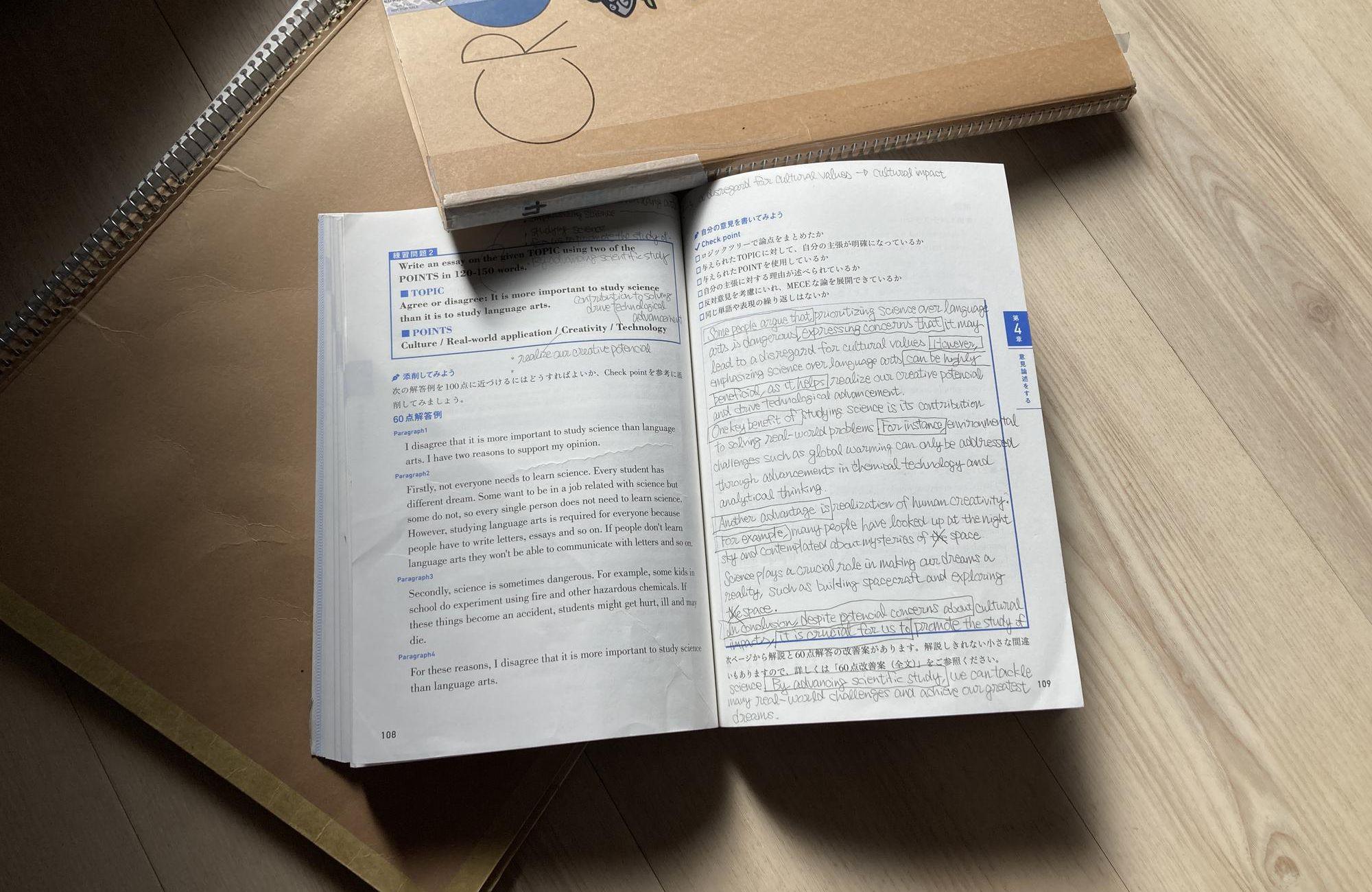Overview
This is the first book specifically focused on writing skills. It's a continuation of the "Road to Eiken Pre-1 Grade" series.
- (2024-10-27) Yukihiko Ayatsuji - THE DECAGON HOUSE MURDERS
- (2024-08-24) The Road to Eiken Pre-1 Grade (2024-08) and 100 Moments of Wonder
As the title suggests, this book provides guidance on tackling the writing section of the Eiken Pre-1 Grade exam. Here's my summary and thoughts.
Reading Notes
Here are some "common mistakes" mentioned in the book that I personally resonate with:
- Don’t start sentences with conjunctions: Apparently, starting sentences with "And," "But," or "Because" is a no-go. Who knew? However, I've often seen this in novels, so perhaps it depends on the context.
- If you must do this↑, use adverbs instead: For example, use "Furthermore," "However," or "Since" instead. That makes sense!
- Using gerund or participial phrases instead of conjunctions is a Pre-1 Grade-level technique: For instance, change "because it improves..." to "improving...". This is one tough skill to master.
- Attach “a” or “-s” to all countable nouns: Ugh… I get it, but it’s so easy to second-guess myself. It’s straightforward for tangible objects, but concepts are tricky.
- Redundancy: Repeating the same words, like "I think," over and over. This applies to Japanese as well. Repeating the same phrases, such as "I think..." in Japanese, gives an immature impression to the reader.
- If you want to do this↑, use synonyms instead: For instance, instead of repeatedly saying, "I think that SVO," try rephrasing it to "S appears to be O."
- To improve this skill, practice describing nouns in English.
- Off-topic: This refers to not answering the question. It’s like being asked, "Want to go to Disney? Yes or no?" and responding with, "Disney’s a great place, isn’t it?" Totally unhelpful.
On the subject of using an English-English dictionary:
- "Use an English-English dictionary." We’ve all heard it a million times, right? It’s exhausting. It feels like an overzealous push for some highbrow hobby. But thanks to this book, I’ve started using one. I finally encountered a convincing reason to integrate it into my life.
- As you advance in your studies, translating everything into Japanese as you read or listen becomes a bottleneck. The higher your level and the stricter the time constraints, the more the English-to-Japanese process causes delays. It becomes impossible to keep up.
- And guess what enables this bad habit? Bilingual dictionaries. Switching to an English-English dictionary made sense. Seriously, the delay caused by translating everything in your head becomes unbearable.
- Practice writing essays using templates repeatedly: Creativity is good, but start by following templates. Shuhari—master the form before breaking away.
- I created my own method based on the templates provided, which I’ll share below.
- No templates for summary writing. Good luck: It seems there’s no shortcut here.
My Essay Writing Process
This is a process devised by Midori-san for essay writing.
- Review the TOPIC and POINTs, and brainstorm one idea per POINT for "just push through."
- Based on the quality of those ideas, decide whether to agree or disagree with the TOPIC.
- Create three rephrasings of the TOPIC by changing the verb or similar.
- Use the "just push through" content to create a "TOPIC helps...POINT" for each POINT.
- Create noun-clause rephrasings for each POINT.
- Formulate a rebuttal to the TOPIC based on the POINTs.
- Write according to the template.
My Essay Writing Template
- Introduction
- Some people argue that
TOPIC as isisnegative rephrasing of TOPIC, expressing concerns that it mayreason for negativity. - However, in my opinion,
rephrased TOPICcan be highly beneficial, as it helpsTOPIC helps...POINT1andTOPIC helps...POINT2.
- Some people argue that
- Body 1
- One key benefit of
short rephrased TOPICisnoun-clause rephrasing of POINT1. - For instance,
just push through here.
- One key benefit of
- Body 2
- Another advantage is
noun-clause rephrasing of POINT2. - For example,
just push through here.
- Another advantage is
- Conclusion
- In conclusion, despite potential concerns about
noun-clause rephrasing of negative reason for TOPIC, it is crucial torephrased TOPIC. - By doing so,
summary of POINTs.
- In conclusion, despite potential concerns about
Thoughts
- Honestly, this book feels like a halfway-there reference guide.
- It introduces various training methods that could improve writing skills, such as describing nouns in English, building logic trees for essays, and editing flawed drafts. But it all feels a bit idealistic—like, sure, it would be great if you had months of guided practice with a tutor scoring your work.
- The book also recommends using ChatGPT for learning and even includes sample prompts.
- In that case, why not just…
- List these training types, then provide ChatGPT prompts for each.
- That would suffice. After listing common mistakes and key points to keep in mind, just include ChatGPT prompts and call it a day. Instead, the book scatters these concepts throughout, which makes it feel disorganized as a whole.
- And this part was awful↓:
- The "Let’s Try Writing" section is too small to write in.
- And this part was even worse↓:
- Why is the space for a “60-70 words” summary larger than for a “120-150 words” essay? This design screams a lack of care. Did they even test the layout before publishing? It feels like a half-hearted handover document.
- That said, what I sought from this book was a clearer plan for studying writing assignments. By reading and summarizing the book in my own way, I got what I needed. The "Shuhari" concept resonated with me the most. I completely agree: start by practicing with templates. I followed through and wrote one myself↓









